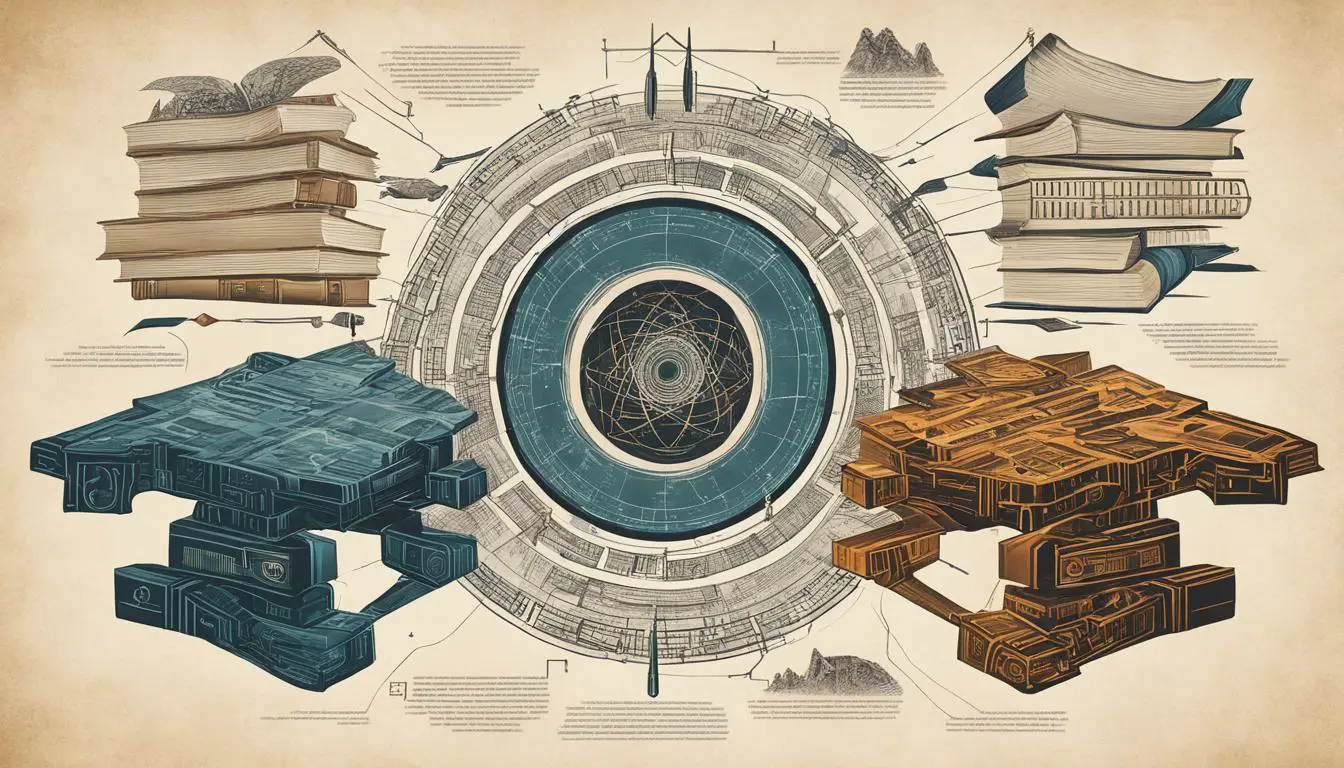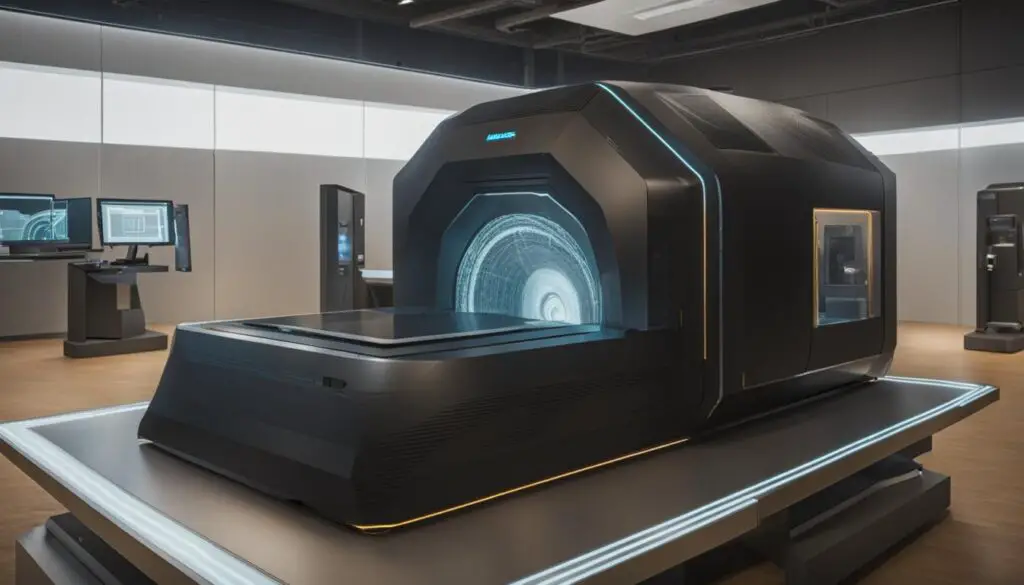
Technology has had a profound impact on our understanding of biblical history. With the help of digital tools, we can now delve deeper into ancient scriptures and archaeological artifacts, gaining valuable insights into the past like never before. The advancements in data analysis, digital research tools, and immersive experiences have revolutionized the field of biblical studies, shedding new light on the events and narratives of ancient times.
Key Takeaways:
- Technology has revolutionized our approach to understanding biblical history.
- Digital tools aid in textual analysis, translation, and interpretation of biblical texts.
- Archaeological discoveries are enhanced by 3D modeling and virtual reality experiences.
- Data analysis provides insights into the historical context of biblical events.
- AI plays a significant role in biblical studies, aiding in language processing and interpretation.
Digital Tools for Biblical Research
Technology has revolutionized the field of biblical research, providing scholars with powerful digital tools that enhance their understanding of ancient texts. With the help of advanced software and databases, biblical research has become more efficient and accurate, enabling scholars to delve deeper into the complexities of biblical history.
One of the key areas where digital tools excel is textual analysis. Scholars can now compare different versions of the Bible, analyze word usage, and identify patterns and meanings that may have been overlooked in the past. This process allows for a more comprehensive understanding of the text and its historical context.
In addition to textual analysis, digital tools also play a crucial role in translation. Translation software has significantly improved the accuracy and speed of biblical translations, ensuring that the message of the scriptures is faithfully conveyed to readers worldwide. These tools enable scholars to explore the nuances of ancient languages, making the process of translation more nuanced and precise.
Moreover, digital tools allow for the preservation and digitization of ancient manuscripts. Through detailed scanning and imaging techniques, fragile and deteriorating manuscripts can be stored and studied digitally, ensuring their long-term preservation. This accessibility allows researchers to conduct in-depth analysis and collaborate across geographical boundaries.
Overall, digital tools have become indispensable in the field of biblical research, providing scholars with the means to uncover new insights and deepen our understanding of the scriptures. By leveraging the power of technology, researchers can continue to push the boundaries of biblical scholarship and shed light on the rich history and wisdom contained within ancient texts.
Archaeological Discoveries in the Digital Age
In the digital age, technology has revolutionized the field of archaeology and transformed our understanding of biblical history. Through the use of cutting-edge tools such as 3D modeling and virtual reality, archaeologists are able to uncover new insights and discoveries about ancient civilizations and biblical times. These technological advancements have opened up exciting avenues of exploration, allowing us to step back in time and experience the past in ways we never thought possible.
One of the most groundbreaking aspects of technology in archaeology is 3D modeling. With this technique, archaeologists can recreate ancient structures, artifacts, and even entire cities with remarkable accuracy. By digitally reconstructing these archaeological finds, researchers can examine minute details, study architectural features, and gain a deeper understanding of the civilizations that once existed.

Virtual reality (VR) has also revolutionized the way we explore and understand biblical history. Through VR experiences, we can immerse ourselves in ancient landscapes, walk through the streets of long-lost cities, and witness historical events unfold before our eyes. This technology allows us to engage with the past on a whole new level, fostering a deeper connection and appreciation for the rich history preserved within the archaeological record.
Not only do these digital advancements enhance our understanding of biblical history, but they also provide valuable opportunities for remote surveys, excavations, and analysis. Using remote sensing technologies, archaeologists can conduct surveys of vast areas from a distance, identifying potential archaeological sites and features. This saves time, resources, and ensures the preservation of delicate archaeological sites.
Additionally, the digital age has paved the way for detailed analysis and documentation of archaeological artifacts. Through high-resolution imaging and advanced data capture techniques, researchers can create virtual catalogs of artifacts, allowing for detailed examination and study without risking damage to the originals. These digital archives also make archaeological findings more accessible to scholars around the world, fostering collaboration and furthering our understanding of the past.
Advantages and Limitations of Digital Archaeology
While the use of technology in archaeological research has undoubtedly transformed the field, it is essential to acknowledge both the advantages and limitations of these digital approaches. Some of the advantages include:
- Improved accuracy in reconstructing ancient structures and artifacts
- Enhanced accessibility and preservation of archaeological findings
- An immersive and interactive way to explore and experience the past
- Remote surveys and analysis, saving time and resources
However, there are also limitations to digital archaeology. These include:
- The reliance on digital models as representations of the actual artifacts and structures
- Data limitations and the need for advanced technological infrastructure
- The potential for biases in the reconstruction and interpretation of the past
- The ongoing challenges of ensuring data accuracy and quality
Despite these limitations, the digital age has undeniably revolutionized the field of archaeology and transformed our understanding of biblical history. As technology continues to advance, we can expect even more exciting discoveries and insights to emerge, further enriching our knowledge of the ancient world.
Historical Context Through Data Analysis
Data analysis plays a crucial role in uncovering the historical context of biblical events. By examining ancient texts, archaeological findings, and the socio-political dynamics of the time, researchers are able to gain valuable insights into the cultural, economic, and religious factors that shaped biblical history.
Through data-driven approaches, patterns and correlations can be identified, providing a more comprehensive understanding of the biblical world. This enables scholars to piece together the intricate tapestry of the past, shedding light on the motivations, beliefs, and interactions of ancient civilizations.
Analyzing historical data allows us to explore the dynamic interplay between different societies and understand how their actions and decisions influenced the course of biblical events. By unraveling the socio-political dynamics of the time, we can better appreciate the broader context in which biblical narratives unfolded.
The Power of Data Analysis
Data analysis enables researchers to identify patterns and trends that may not be apparent on the surface. By examining large datasets and applying statistical methods, we can uncover hidden insights that contribute to our understanding of biblical history.
“Data analysis allows us to discern the underlying currents of biblical events, revealing connections and relationships that may have otherwise remained obscured.”
This approach helps to validate or challenge existing assumptions and theories, promoting a more evidence-based understanding of biblical history. Furthermore, data analysis fosters interdisciplinary collaboration by bringing together scholars from various fields, such as archaeology, history, and sociology, to collectively piece together the puzzle of the past.
The Role of Ancient Texts and Archaeological Findings
Ancient texts and archaeological findings provide invaluable primary sources for data analysis in biblical research. By meticulously examining texts such as papyrus scrolls, clay tablets, and inscriptions, scholars can extract valuable information about the beliefs, practices, and historical events of biblical times.
Similarly, archaeological discoveries offer tangible evidence that complements textual analysis. Excavations and artifact examinations provide insights into the material culture and daily life of ancient civilizations. By combining textual and archaeological data, researchers can gain a more holistic understanding of biblical stories and events.
The Role of AI in Biblical Studies
Artificial intelligence (AI) has revolutionized the field of biblical studies, offering new possibilities for understanding ancient texts and uncovering deeper meanings. By harnessing the power of AI, scholars can delve into the complexities of biblical narratives, unlocking insights that were previously hidden.
One of the key applications of AI in biblical studies is language processing. By utilizing natural language processing algorithms, AI systems can analyze vast amounts of biblical texts, cross-referencing different passages, and identifying linguistic patterns. This enables scholars to gain a deeper understanding of the nuances of biblical languages and interpret the scriptures with greater accuracy.
AI also plays a crucial role in translation and interpretation. With its advanced capabilities, AI-powered translation software can assist in accurately translating biblical texts from their original languages into modern languages, bridging any linguistic gaps and facilitating international scholarly collaborations. Additionally, AI-based interpretation tools help scholars interpret complex passages, providing valuable contextual information and aiding in the understanding of symbolic language often found in biblical texts.
“AI brings a new dimension to the study of biblical texts. It allows us to analyze large datasets effortlessly and spot patterns that were previously unseen. This not only enriches our understanding of the scriptures but also opens up new avenues for research and interpretation.”
Furthermore, AI has the potential to reconstruct ancient languages that are no longer spoken or have limited resources available. Using machine learning techniques, AI algorithms can process existing linguistic data and reconstruct the potential pronunciations and grammatical structures of these ancient languages. This aids scholars in piecing together the historical context and understanding how the languages of biblical times sounded and functioned.
The role of AI in biblical studies extends beyond language processing and interpretation. It also assists in data analysis, enabling scholars to identify patterns, correlations, and themes within biblical texts. By leveraging AI’s computational power, researchers can analyze and visualize large datasets, uncovering previously unnoticed connections and shedding light on the socio-political dynamics of biblical times.
As AI continues to advance, future applications in biblical studies are limitless. From developing virtual assistants for biblical research to creating immersive experiences that transport scholars back in time, AI has the potential to reshape how we study and engage with biblical history.

Applications of AI in Biblical Studies
| Application | Description |
|---|---|
| Language Processing | Utilizing natural language processing algorithms to analyze biblical texts, identify linguistic patterns, and improve language translation and interpretation. |
| Reconstructing Ancient Languages | Using machine learning to reconstruct ancient languages, allowing scholars to understand the pronunciation and grammar of biblical languages. |
| Data Analysis | Applying AI to analyze large datasets of biblical texts, uncover patterns, correlations, and socio-political dynamics. |
| Interpretation Assistance | AI-based tools that assist in interpreting complex biblical passages and provide contextual information. |
| Virtual Reality Experiences | Developing immersive experiences that enable scholars to explore biblical sites and events in virtual reality. |
Virtual Reconstructions and Interactive Experiences
Thanks to virtual reconstructions and interactive experiences, we can now engage with biblical sites and events in a whole new way. Through virtual reality (VR) and augmented reality (AR) technologies, we can explore ancient cities, walk through reconstructed temples, and witness biblical narratives come to life. These immersive experiences provide a deeper level of engagement and understanding, allowing us to visualize and experience biblical history like never before.
Imagine standing in the heart of Jerusalem during the time of Jesus, surrounded by the authentic architecture and bustling streets of that era. Through virtual reconstructions, we can step back in time and experience the sights and sounds of biblical times right before our eyes.
Additionally, interactive experiences enable us to actively participate in biblical stories and events. We can become part of the narrative, making choices and experiencing the consequences. By immersing ourselves in these interactive journeys, we develop a deeper connection and appreciation for the biblical texts.
“Virtual reconstructions and interactive experiences bridge the gap between the ancient and the modern, allowing us to walk in the footsteps of our biblical ancestors and gain a firsthand understanding of their lives and experiences.”
Whether it’s exploring the grandeur of the Temple of Solomon or witnessing the parting of the Red Sea, these virtual and interactive experiences bring the Bible to life in a profound and impactful way. They enable us to connect with the past, grasp the cultural and historical contexts more intimately, and cultivate a deeper understanding of the biblical narrative.
These technologies not only cater to our innate curiosity but also serve as valuable educational tools. Students and scholars can engage with biblical sites and events without the limitations of physical travel. This accessibility opens up new possibilities for learning and research, allowing individuals from all over the world to delve into the rich tapestry of biblical history.
Benefits of Virtual Reconstructions and Interactive Experiences:
- Immersive engagement with biblical sites and events
- Enhanced understanding and appreciation of biblical history
- Active participation in the biblical narrative
- Development of a deeper connection to biblical texts
- Opportunities for virtual learning and research
With the continuous advancement of immersive technology, virtual reconstructions, and interactive experiences, we can continue to explore and uncover the wonders of biblical history. These technologies enable us to step into the footsteps of our ancestors, breathe life into ancient stories, and gain a profound understanding of the enduring impact of the biblical narrative.
| Advantages | Disadvantages |
|---|---|
| Provides a realistic and visually captivating experience | Costly to develop and implement |
| Accessible to individuals worldwide, regardless of location | Requires specialized equipment or devices |
| Promotes active learning and engagement | May not fully replicate the authenticity of historical sites |
| Offers opportunities for virtual research and exploration | Might not be accessible to individuals with certain physical disabilities |
The Future of Technological Advancements in Biblical Studies
Looking ahead, the future of technological advancements in biblical studies is filled with exciting possibilities. As AI continues its rapid evolution, the field of biblical studies stands to benefit greatly from more advanced language processing algorithms, improved translation software, and enhanced data analysis techniques. These advancements will undoubtedly revolutionize the way we understand and interpret biblical texts, offering new insights and perspectives on ancient scriptures.
One area where technological advancements will make a significant impact is in virtual reality (VR) experiences. VR technologies are becoming increasingly immersive, allowing researchers and enthusiasts to have even more realistic and interactive encounters with biblical narratives. Imagine being transported to the streets of ancient Jerusalem or witnessing the parting of the Red Sea firsthand. VR experiences not only bring the scriptures to life but also provide a deeper level of engagement and understanding.
Furthermore, AI-driven data analysis will continue to play a crucial role in our exploration of biblical history. By leveraging AI’s capabilities, scholars can analyze vast amounts of data, cross-referencing different passages and identifying linguistic patterns. This enables a deeper understanding of the context and meaning behind biblical texts. AI can also assist in the interpretation of complex ancient languages, aiding in the reconstruction of lost linguistic nuances.
The future also holds promise for the development of more user-friendly digital tools tailored specifically for biblical research. These tools will simplify the process of textual analysis, enabling scholars and enthusiasts to delve deeper into the intricacies of ancient scriptures. They will facilitate comparative studies, textual criticism, and unlock hidden insights embedded within the text.
To summarize, the future of technological advancements in biblical studies is a bright one. The continued evolution of AI, the immersive experiences offered by VR, and the expanding capabilities of data analysis will revolutionize the way we understand biblical history. Through these advancements, we will gain new perspectives, uncover hidden meanings, and truly appreciate the richness of ancient scriptures.
Conclusion
The impact of technology on our understanding of biblical history cannot be overstated. Through the use of digital tools, such as those that aid in textual analysis and translation, we have gained unprecedented insights into ancient scriptures. The ability to compare different versions of the Bible, analyze word usage, and uncover hidden patterns has enhanced our knowledge and interpretation of the past.
Furthermore, technological advancements have greatly facilitated archaeological discoveries related to biblical history. Through 3D modeling and virtual reality experiences, we can now explore ancient structures and artifacts with a depth and realism that was previously unimaginable. These digital tools have revolutionized the way we study and interpret the past, bringing us closer to the events and people depicted in biblical narratives.
Looking to the future, ongoing advancements in technologies like AI and data analysis hold tremendous potential for deepening our understanding of biblical history. AI’s natural language processing algorithms can help us unravel linguistic patterns and aid in translation, while data analysis allows us to uncover socio-political dynamics and historical context. By embracing and harnessing these digital tools, we can continue to unlock new insights and interpretations, enriching our understanding of the past for generations to come.
FAQ
How has technology impacted our understanding of biblical history?
Technology has revolutionized the way we approach and understand biblical history. With advancements in digital tools, archaeological discoveries, and data analysis, we can gain valuable insights into ancient scriptures and artifacts like never before.
What digital tools are available for biblical research?
Scholars now have access to advanced software and databases that aid in textual analysis, translation, and interpretation of biblical texts. These tools enable them to compare different versions of the Bible, analyze word usage, and uncover hidden patterns and meanings.
How has technology contributed to archaeological discoveries related to biblical history?
Digital advancements, such as 3D modeling and virtual reality experiences, have revolutionized the way we explore and understand the past. Technology allows archaeologists to conduct remote surveys, excavations, and analysis, leading to new insights and discoveries about biblical times.
How does data analysis help in understanding the historical context of biblical events?
By analyzing ancient texts, archaeological findings, and socio-political dynamics of the time, researchers can gain a deeper understanding of the cultural, economic, and religious factors that shaped biblical history. Data-driven approaches help uncover patterns and correlations, providing a more comprehensive picture of the biblical world.
What role does AI play in biblical studies?
Artificial intelligence (AI) has emerged as a powerful tool in biblical studies. Natural language processing algorithms can analyze vast amounts of biblical texts, cross-referencing different passages and identifying linguistic patterns. AI can aid in translation, interpretation, and even reconstructing ancient languages.
How do virtual reconstructions and interactive experiences enhance our understanding of biblical history?
Through virtual reality (VR) and augmented reality (AR) technologies, we can explore ancient cities, walk through reconstructed temples, and witness biblical narratives come to life. These immersive experiences provide a deeper level of engagement and understanding, allowing us to visualize and experience biblical history like never before.
What can we expect in the future of technological advancements in biblical studies?
As AI continues to evolve, we can expect more advanced language processing algorithms, improved translation software, and enhanced data analysis techniques. Virtual reality experiences will become more immersive, allowing for even more realistic and interactive encounters with biblical narratives.
How has technology impacted our understanding of biblical history overall?
Technology has undeniably had a significant impact on our understanding of biblical history. From digital tools that aid in textual analysis and translation to archaeological discoveries enhanced by 3D modeling and virtual reality, technology has revolutionized the field of biblical studies.








